
Demobilisation after WW2
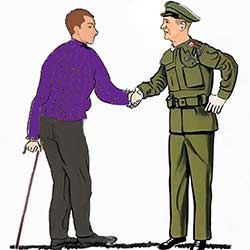
Do you know what the following terms mean: 'Demobbed', 'Civvy Street', 'Partial demobilisation', 'repatriation', 'demob suit', 'final discharge' and 'war service medal'? They were on everyone's lips in the UK at the end of World War Two and you can learn history through them. This page explains, but more than that, it includes the emotions that accompanied them from the personal experiences of people who lived through those times.
____
By the webmaster based on early recollections with additional research and contributions
At the end of WW2 there was a lot of adjustment required, both for the returning service-men and the women who stayed behind on the home front. This page tries to catch the emotion as well as the facts of the time through the terms that were then in common usage.
'Demobbed' and 'demobilisation' - meanings
"When he is demobbed ..." was a term that I learnt quickly in my childhood in the early 1940s. 'Demobbed' was short for 'demobilised'. It meant the process of releasing troops from active service.
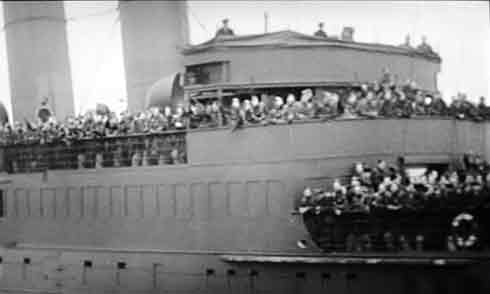
British troop ship returning servicemen for demobilisation at the end of the Second World War.
The great majority of the World War Two forces personnel were not career servicemen. They had simply been legally required to join one of the armed forces or undertake some form of war work. For this, they had been 'called up'; at the beginning of the war or in its early years. Then, at the end of the war, when their services were no longer required, they were demobilised - commonly known as 'demobbed. In practice they were able to go back home quite quickly although their formal demobilisation took time.
For troops serving overseas, getting back home was not quick. There is more on formal demobilisation below. First, though, some more common terms to show he atmosphere of the time.
Civvy Street
Another phrase which was common at the time, but which would probably not be understood by anyone who did not live through the end of the war was 'civvy street'. It meant 'life as a civilian', ie in a world which was not at war. It was normally used in connection with earning one's living, ie employment.
During the war, I often heard questions from one woman to another, like, "What did your husband do in civvy street?" meaning "What was his job before the war?"
The term could frequently be heard after the war too, when men who felt that the war had changed them, did not know what to do with their futures, "back in civvy street".
The 'demob suit'- meaning
A complete set of civilian clothing, which came to be known as the 'demob suit', was given to every serviceman on his demobilisation and it included underwear and shoes. The aim was to help servicemen return to civilian life and work. It soon became a flippant term for any suit that looked inappropriate or worse for wear.
I was never aware at the time of my father wearing a demob suit, but maybe he did. I understand that the suits were good quality, were not utility and were provided off-ration, even though rationing was still in operation in the UK. Photos seem to show them as double-breasted, pin-striped. They were not, however necessarily a good fit. because of stocks running low. It must have been a major economic and industrial effort to stock every demobilised serviceman.
The men were allowed to keep their service uniforms, but I can't remember seeing my father in his after the war. I expect that the men couldn't discard them and their demob suits quickly enough as they wanted to get on with normal civilian life.
Career prospects
Demobbed service personnel generally had the right to return to their original employment - often to the distress of the women who had taken their place in the workplace and now felt a sense of loss. Also, those demobbed service personnel who wished could participate in the Government's Further Education and Training Scheme which paid university fees and an annual means-tested grant of up to £426 to cover living expenses whilst studying.
Partial demobilisation, 1946
The demobilisation process took time, as men in the armed forces were stationed across the world. Even my father, who had a desk job in England, was not demobbed until 1946 and then it was only partial release in that it was to the Territorial Army Reserves - see the following 'release paper'.
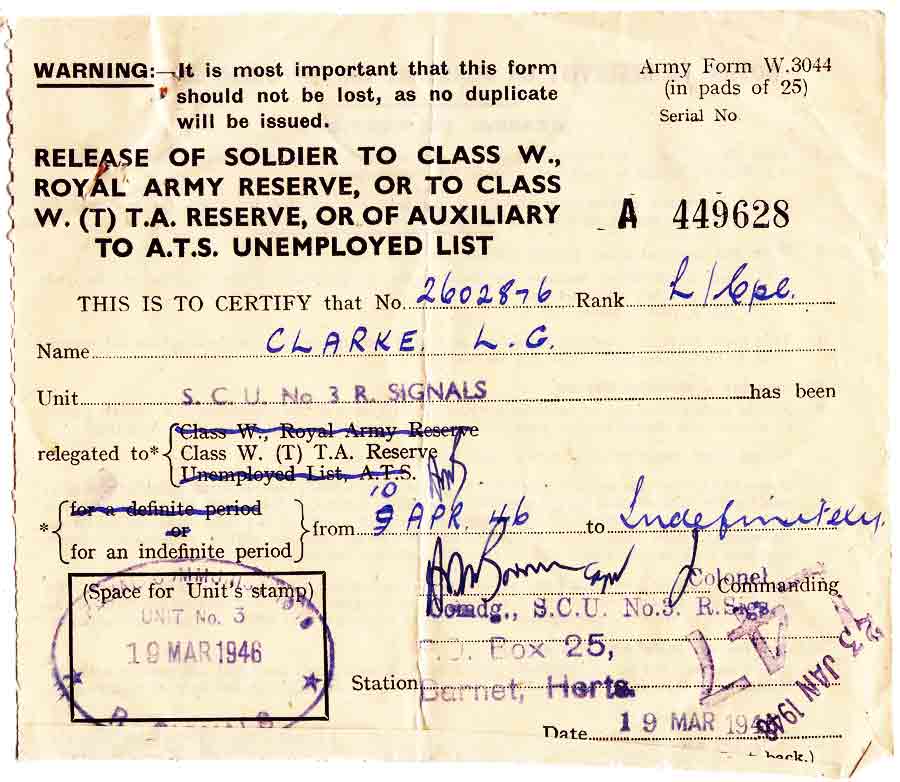
My father's 1946 interim war release certificate to the Territorial Reserves. Tap/click to enlarge to a legible size.
These partial releases were probably a safety measure while the world was sorting itself out after the turmoil of the war. As far as I know, my father was never asked to do any work or attend any meetings in connection with the Territorial Army Reserves.
Prisoners of war (POWs) return
It also took time to repatriate British prisoners of war (POWs), particularly those the other side of the world in Japan, and even when they arrived home, they needed a recuperation period as conditions in the POW camps had been so bad.
Repatriation of POWs from Singapore
A colleague who had been a prisoner of war in the notorious Changi Jail in Singapore explained to me why repatriation of POWs from there took so long. He was not very complimentary about the British Government.
Apparently after the Japanese capitulation in WW2, the Americans and Australians flew planes round the clock to repatriate their ex-POWs. The Brits had to wait - sometimes many months for ships to come and collect them.
My colleague was eventually sent home in a ship that had been used to transport supplies from the USA in the war. Below decks had been quickly converted into sleeping accommodation with mattresses on the floor. He said it was good job they had had to wait as they had had time to build up their strengths for such a journey after the privations in the camp. The ex-POWs rigged up blankets and sheets on the deck where they slept and spent most of the day there until forced below by the bad weather in the Bay of Biscay.
I am not sure how typical this experience was but I don't think he was exaggerating his.
Norman Groocock
Official final discharge
Demobilisation was not the same as discharge. Even once service personnel were home, they were not yet formally discharged. That came later and was not quick in coming.
My father was not completely out of the armed forces until April 1948 - see his discharge paper below.
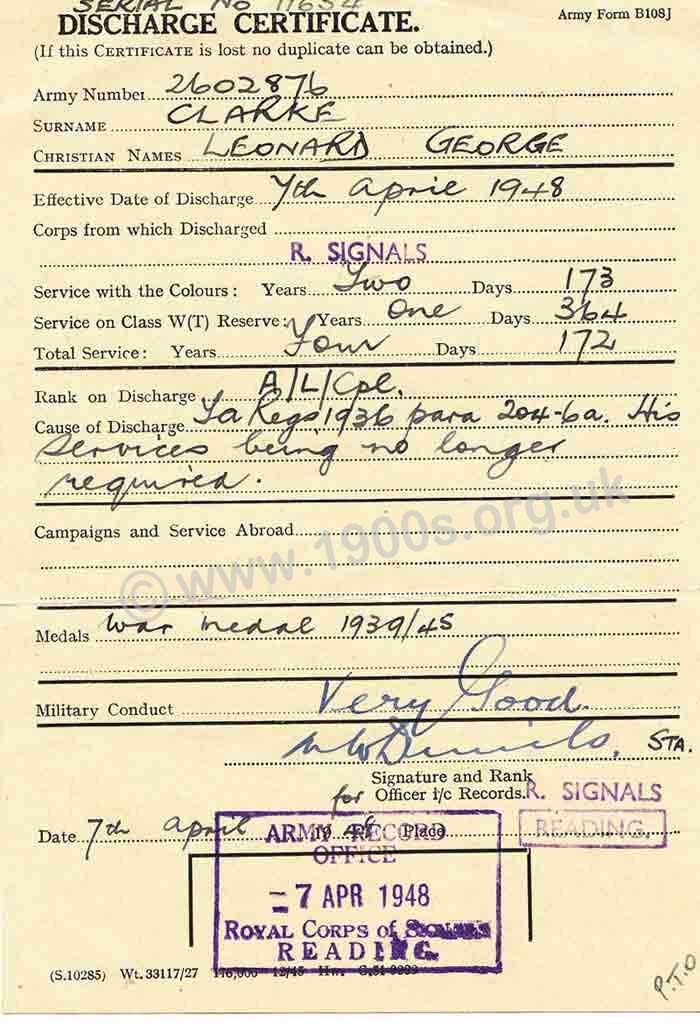
My father's 1948 total release certificate. Tap/click to enlarge to a legible size.
My father - due to his age and poor hearing - never left England during the war. So I was surprised to read on his discharge certificate that he had been awarded a war medal.
The war service medal
All full-time personnel of the armed forces, wherever they were serving, so long as they had served for at least 28 days between September 1939 and September 1945 were eligible for the war medal. The British version was 36mm in diameter and struck in cupro-nickel. One side showed the head of King George VI and the other a triumphant lion trampling on a dragon, signifying the power of victory.
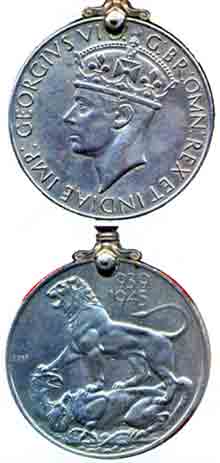
1939-1945 War Medal, photo courtesy of the Royal Signals Archives
I don't know if these medals were sent to the individuals concerned or whether they had to be applied for. Certainly I never saw one in our house. I think my father, like most people, just wanted to forget the war.
sources: early 20th century material
sources: ww2 home front and other material
contact
the webmaster/author/researcher/editor
privacy policy
















